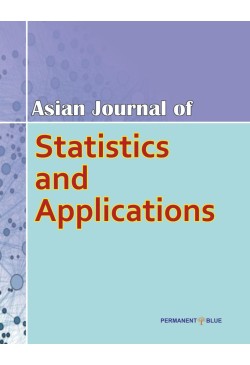
Asian Journal of Statistics and Applications
Frequency :Bi-Annual: Language: English: Year: 2024: publication – online: Subject: Mathematics
ISSN :3048-7455
Peer Reviewed Journal
Odds One Parameter Polynomial Exponential - G Family of Distributions
To model lifetime data, the study suggests a new class of distributions termed the Odds One Parameter Polynomial Exponential-G family of distributions. Incomplete moments, Mean deviations, Lorenz and Bonferroni curves, Moments of residual and reversed residual life, Shape, Quantile function, Entropy, Order Statistics, Stress-Strength reliability, and other structural and reliability properties are discussed. Estimation of the parameters involved has been described by the maximum likelihood method. The results of simulation studies have been reported. Four data sets have been analyzed to demonstrate the applicability of the class of distributions.
KEYWORDS: Mixture distribution, Odds function, Reliability properties, Structural properties, T-X family of distributions.
Analyzing the Phenomenon of ‘Mail-in-Brides’: A Census-Based Study of Marital Patterns
Comparable to the notorious “mail-order bride” phenomenon India also has “mailin” or “bought brides,” or “Paro” or “mol ki bahuein.” To determine the approximate population of these women, the article looks at the states in northern India. The current study uses balanced calculations to follow those women using a three-step procedure, and it is based on census data from 1991 to 2011. This paper first identifies the low and imbalanced sex ratio regions that have affected the demand for brides from other states; second, it tracks potential supply areas through unexpected female presences resulting from marriage-migration; and finally, it attempts to calculate the number of these trafficked or traded brides using basic balanced equations. According to the investigation, Haryana is the most vulnerable area among those like Bihar, Chattishgarh, Himachal Pradesh, Jharkhand, Madhya Pradesh, Punjab, Rajasthan, Uttar Pradesh, and Uttrakhand. Data over thirty years indicates that 32.9, 6.3, 25.6, and 14.2 percent of women more than men in rural-rural, ruralurban, urban-rural, and urban-urban areas, respectively, migrated from Punjab to Haryana for marriage. In contrast, Rajasthan saw a 74.5 percent increase in female migration than male in the rural-rural frame to Haryana. The circumstances get
more intriguing for Uttar Pradesh. In other words, roughly 1752 women, who might not have chosen to come to Haryana, arrived each year between 1991-2001. The study’s findings indicated that a focused survey and the implementation of policies are desperately needed in order to safeguard women and their children against abuse, human trafficking, resale, and other forms of abandonment.
KEYWORDS: Mail-in-bride, Women Trafficking, Estimation,
Smoothing Census Age Returns Using Interpolation
The paper examines the adjustment of self-reported age data in Indian censuses. In this study, we attempted to smooth out the approximation of end digits in age reporting by adjustment of single-year age returns in Indian census data for 1991, 2001 and 2011. The primary objective of this study is to provide a reliable base population unaffected by digit preferences or avoidances. The proposed adjustment is based on the interpolation of equidistance arguments. Interpolation of equidistance arguments was applied for obtaining adjusted single-year age returns from the reported data by age and sex for the 1991, 2001, and 2011 Indian censuses. Adjusted data was re-evaluated for the presence of age errors. Myers Index, Whipple’s Index, and Total Modified Whipple’s Index were used to compare heaping in reported age data and adjusted age data. The re-evaluation of adjusted data shows that the quality of adjusted data was far better than the original self-reported data. Therefore, it is recommended that the adjusted data, being almost unaffected by digit preferences or avoidances, may be used as a base population for estimation of various demographic parameters.
KEYWORDS: Adjustment of single-year age returns, India, Census, Myers Index, Whipple’s Index, Total Modified Whipple’s Index
An Application of Stochastic Modelling to COVID-19 Infections data of India
In this article it is tried to construct a stochastic model which can be used to describe biological growth phenomena that roughly shows an exponential pattern but there is a resistance force(could be manual) acting on it.It is mainly constructed to explain growth dynamics of infected patients by COVID-19 in those countries where an early lockdown was imposed.Here it is attempted to find the expression of variable of interest at time t and also the MLEs of model parameters are worked out.This model is applied to a real life data of infected patients by COVID-19 in India, specially for the period in which there was a strict lockdown around the country. Then a comparative study is made with exponential model that could be a possible option to describe such situation. This model could be used to the data of any country, where an early lockdown decision was made as a precautionary measure to deal with this situation.This article aims to see whether there is any impact of the resistant force or not.
KEYWORDS: COVID-19, Ito’s Lemma, Growth deceleration factor, Exponential model.
A Class of Chain Type Estimators for Population Mean Under Two Phase Sampling Using Available Information on Second Variable
We have considered a class of modified ratio-product estimators for finite population mean which make use of coefficient of skewness, coefficient of kurtosis and coefficient of variation of first auxiliary variables. The proposed estimators have been compared with conventional ratio estimator, product type estimators. The results obtained has been demonstrated with numerical illustration carried over the data set of natural population. Suitable recommendation has been put forward to the survey statistician for application in real life population.
KEYWORDS: Ratio estimator, product estimator, finite population mean, double sampling, study variable, auxiliary variable, chain-type, regression type, coefficient of skewness, coefficient of kurtosis, coefficient of variation, bias, mean squared error.